Partnerships in the Pandemic Spotlight: McCall Outdoor Science School
By Cristina Edwards and Emilie Lygren
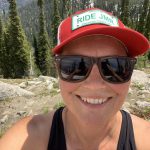
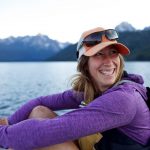 Karla Eitel (right) is the Director of the McCall Outdoor Science School, a residential outdoor science program located in McCall, Idaho. She also teaches a place-based education class to graduate students at the University of Idaho College for Natural Resources. Beth Kochevar (left) is the K-12 Residential and Outreach Programs Coordinator at the McCall Outdoor Science School Field Campus.
Karla Eitel (right) is the Director of the McCall Outdoor Science School, a residential outdoor science program located in McCall, Idaho. She also teaches a place-based education class to graduate students at the University of Idaho College for Natural Resources. Beth Kochevar (left) is the K-12 Residential and Outreach Programs Coordinator at the McCall Outdoor Science School Field Campus.
In our interview, Karla and Beth describe how their existing partnerships with their K-12 school district led to the creation of an in-person outdoor learning program during the pandemic, and how they called on resources and relief available through the district and the CARES Act to create infrastructure to support this program. They also share their safety practices and protocols, and offer perspectives on how inviting a local public health specialist to visit and evaluate the program informed their thinking and decision making related to risk management.
This interview is part of our Partnerships in the Pandemic series on outdoor, in-person learning.
BEETLES: Can you share a little about the logistics of this partnership? How did it come about? How did you build this connection with the district, school, or classroom? Who is working with students, and how is it funded?
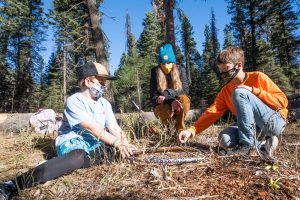 Karla: As we were watching the pandemic develop and impact the world, we had a brainstorming conversation about how we could continue to live out our mission under this Covid world. One idea that came up was partnering with our local school district. When we first reached out to the school district about this idea in the spring, people were really hopeful that we would be back in person in school in the fall. But in the middle of the summer, we got a call from the superintendent who was reading the landscape and was seeing it would not be a reality to be back in person when the school year started. The district was committed to making some in-person learning happen, and initially proposed the idea of providing in-person instruction for all of the students in the district, which is two elementary schools, one middle school, and one high school.
Karla: As we were watching the pandemic develop and impact the world, we had a brainstorming conversation about how we could continue to live out our mission under this Covid world. One idea that came up was partnering with our local school district. When we first reached out to the school district about this idea in the spring, people were really hopeful that we would be back in person in school in the fall. But in the middle of the summer, we got a call from the superintendent who was reading the landscape and was seeing it would not be a reality to be back in person when the school year started. The district was committed to making some in-person learning happen, and initially proposed the idea of providing in-person instruction for all of the students in the district, which is two elementary schools, one middle school, and one high school.
There was no way our organization had the capacity to serve everyone, so we asked if we could focus on elementary school students, because that’s where parents need the most support. We found that we had to narrow even further to maintain a safe instructor-student ratio. Because we weren’t able to realize the ideal of being able to work with every student in the district we tried to think about making the programming as equitable as possible. In enrolling, we tried to prioritize children of essential workers who didn’t have other options for childcare. We also set aside spots for students who qualify for free and reduced lunch, and offered scholarships for those students.
Beth: We’ve been working closely with this district on programming since 2005. We usually host a week of our residential program for the local 5th graders to attend. Over the years we’ve had a couple of Americorps members from our organization who work in the district with local grades, and interweave our model of place based and environmental education in students’ schoolyards.
Karla: Right, this wasn’t a new partnership, but a pivot motivated from all sides.
BEETLES: Please describe the partnership between your organization and the district, school, or classroom you’re partnering with.
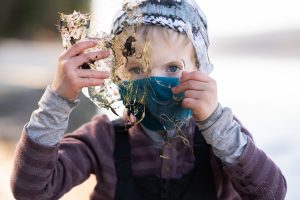 Beth: The local school district is holding in-person instruction on alternating days–so cohorts of students are in school Mondays and Wednesdays with alternating Fridays, or Tuesdays and Thursdays with alternating Fridays. So we have two different cohorts of students coming on their non-school days. There are 50 students per cohort, 100 students total. Students split into field groups of 10.
Beth: The local school district is holding in-person instruction on alternating days–so cohorts of students are in school Mondays and Wednesdays with alternating Fridays, or Tuesdays and Thursdays with alternating Fridays. So we have two different cohorts of students coming on their non-school days. There are 50 students per cohort, 100 students total. Students split into field groups of 10.
The instructors are Americorps members and grad students living on our site, in our student cabins to maintain social distance. Students use district buses to get to the campus, and the district is using a grant they received during the pandemic to provide free lunches to the whole district, so anyone can get lunch who wants it when they are out at our site.
BEETLES: How is it going so far? What have been some successes and challenges that have emerged?
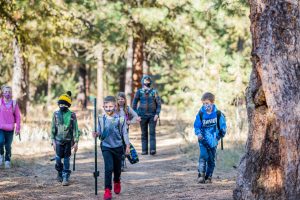 Beth: We have multi-age groups, to respect existing pandemic pods and Covid bubbles, and to ensure that students who are siblings are in the same group. To form our bubbles, we also took input from parents about who their children were seeing and socializing with outside of school.
Beth: We have multi-age groups, to respect existing pandemic pods and Covid bubbles, and to ensure that students who are siblings are in the same group. To form our bubbles, we also took input from parents about who their children were seeing and socializing with outside of school.
There is a K-5 age spread, and trying to adapt the residential curriculum to a full-semester long program has been a challenge. Differentiating enough for students from a big range of different ages has been a challenge. We’re finding ways for students at different ages to split up into smaller groups of closer ages within their cohorts and field groups. Some of the student management challenges we’ve run into are exacerbated by siblings being in the same field group and having disagreements, which we weren’t expecting.
To respond to this, in the winter and spring we’re going to reform bubbles/cohorts and put students in groups based on grade and age instead of having siblings in the same group. That brings its own set of challenges, but it parallels the district policies and what students are doing in their own school attendance. Hopefully this will allow instructors to go a little deeper into the topics.
Karla: There’s a social emotional component that’s not a side piece, but is a big part of the learning. It’s been challenging for instructors, and it hasn’t always been possible to differentiate for such a wide range of ages, and we’re spending more time on student management, but the instructors are really reflecting on their role and what they’re trying to do. It’s led to some interesting conversations. I want to come back to this in May and reflect, How did the students develop? We had a conversation about how there is an advantage instructors have this year that they don’t as residential outdoor educators. They get to see student growth and development over time. They need to manage these relationships over time and are getting to know students and know the individual needs of students in a deeper way, and that’s really cool.
BEETLES: How has your organization adapted to Covid-related physical distancing requirements?
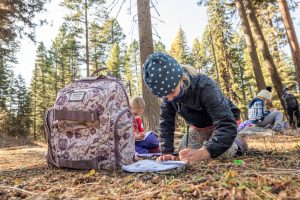 Beth: Since we’re a part of the University of Idaho, we were able to get money from the CARES Act and use it to put up 16×24 wall tents. We have one for each of the field groups, and they have wood stoves inside of them. Instructors arrive early in the morning and start fires in the tents to try to get them a little warm for when the kids arrive. Kids don’t spend a ton of time in the tents, but it’s a place to come back to to warm up if needed. There are whiteboards in the tent, but our educators are really using the place as co-instructor instead of teaching in the tents.
Beth: Since we’re a part of the University of Idaho, we were able to get money from the CARES Act and use it to put up 16×24 wall tents. We have one for each of the field groups, and they have wood stoves inside of them. Instructors arrive early in the morning and start fires in the tents to try to get them a little warm for when the kids arrive. Kids don’t spend a ton of time in the tents, but it’s a place to come back to to warm up if needed. There are whiteboards in the tent, but our educators are really using the place as co-instructor instead of teaching in the tents.
Students wear masks all day. That’s a part of their enrollment package, and is a part of a pledge students and parents sign before they come to us: committing to keeping ourselves and our communities safe by physically distance as much as possible; taking care of one another’s emotional and physical needs; and wearing masks. It would be interesting to refer back to this pledge with students. We haven’t done that yet. Mask compliance is fantastic, parents and families are supportive of that. A representative from the health department came and told us that our mask compliance is great, which is really, really important. It feels good that we’re setting a standard of community care.
One really big challenge is maintaining physical distance. It’s really important that students have social time and have some proximity, and I think that’s something students look forward to when they come here. It gets so exhausting for the instructors to remind kids to take steps backwards to stay six feet apart. The recommendation we got from the health department representative is to keep those field groups as distinct as possible, so if there is any positive Covid case in a group, the contact tracing is much simpler. So we’re trying to limit field groups engaging with one another, and trying to keep the stable pods. It was helpful to hear from a public health representative that doing the best we can do with social distancing is great, when it’s combined with mask wearing and having stable pods.
Karla: We’ve acknowledged what risks we’re taking. Considering instructor fatigue and supporting them to build a positive relationship with the students is a priority. We know that we’re just one context. We’re acknowledging these groups are just one pod, and if there’s an exposure, we have to deal with that. The risk of having students in closer physical proximity at times is in conversation with the rest of the risks.
Beth: From what I’ve been made aware, we have not had any Covid cases or need to contact trace.
BEETLES: How have you considered equity and access in setting up this partnership, and where could you improve in this area?
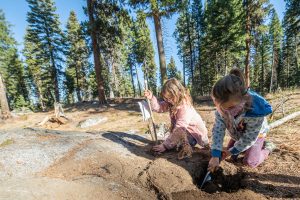 Beth: Like many other programs we are weighing many things here, including the need to survive as an organization. We’re a tuition-based program, and we want to serve our community. Our goal in the fall was for our program to try to mirror the demographics in the district of students on free and reduced lunch students. We didn’t quite meet that percentage, so we’re expanding our scholarship program in the winter. I’ve been working with teachers at the elementary school to attempt to enroll more students in the English Language Learner program, and special education students. Many students in the special education group already have the opportunity to be in-person five days a week at school, so I’m not quite sure how or if to expand that representation here.
Beth: Like many other programs we are weighing many things here, including the need to survive as an organization. We’re a tuition-based program, and we want to serve our community. Our goal in the fall was for our program to try to mirror the demographics in the district of students on free and reduced lunch students. We didn’t quite meet that percentage, so we’re expanding our scholarship program in the winter. I’ve been working with teachers at the elementary school to attempt to enroll more students in the English Language Learner program, and special education students. Many students in the special education group already have the opportunity to be in-person five days a week at school, so I’m not quite sure how or if to expand that representation here.
Karla: With our current organization capacity we aren’t able to increase the capacity of the number of students we’re serving, but if we were able to provide aftercare that would be useful and might encourage more enrollment. Unfortunately that’s not something we have the capacity to do.
Parents would prefer if they could enroll their kids a day at a time, but that would be really hard. We’re maintaining pods and don’t want to have switching or mixing. Part of it is managing feedback and family interactions too; it’s not possible to manage logistics for students only showing up one day at a time. Like everybody these days, we’re doing the best we can and recognize we can’t meet all of the needs and desires within the community.
BEETLES: What are your plans for this collaboration in the future, both in the short term and in the longer term? Would you consider continuing to form these kinds of partnerships when the pandemic “ends” or when schools return permanently to in-person instruction?
Karla: There have been some parents and teachers who have said, “Wouldn’t it be great if we continued this kind of thing?” Exactly what that might look like is a question mark.
By the Numbers
- Students served: 168
- Instructors employed: 2 full time staff, 6 AmeriCorps members; 12 graduate students using this experience as a teaching practicum
- Incidence of Covid at the time of this interview: none
Read about how other programs are navigating outdoor, in-person learning: Partnerships in the Pandemic.

Leave a Response